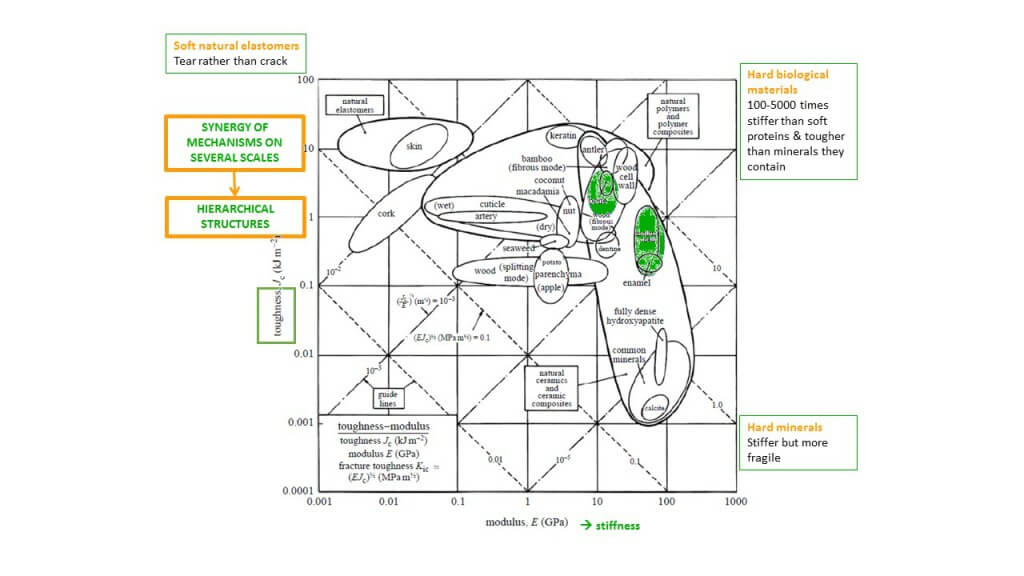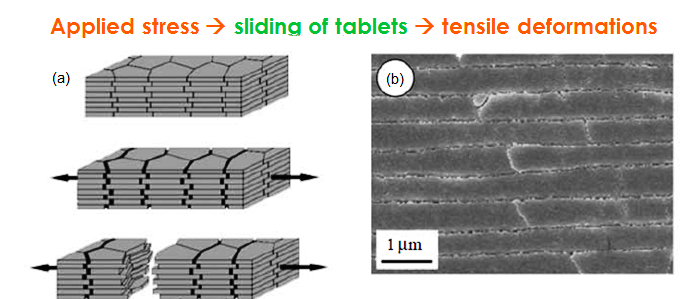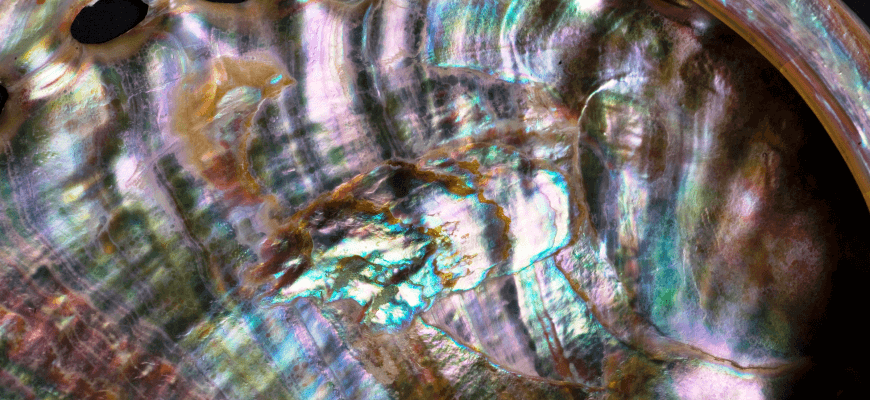I am pretty sure every one of you has already heard about a super natural material – spider silk which is lightweight but at the same time tougher than steel. It has been a topic of engineering research for many years, with the aim to synthetically produce it but so far with no real success. Recently the engineering community is trying to learn more and more from nature since the natural and manmade materials often use different ways to solve similar technical problems. No problem with that, it’s just that natural materials have many special properties which we are unable to mimic – miniaturization, adaptability and multifunctionality. A nice study has been written by François Barthelate in 2007: “Biomimetics for next generation materials” [1] which I will present in this article.
Hard materials:
Natural hard tissues are attracting a lot of attention from researches for their unique combinations of stiffness (resistance to deformation) and toughness (resistance to cracking). They serve different purposes – mechanical support (bones), cutting, tearing and crushing (teeth) and armoured protection (seashells). The recipe for such remarkable properties is to combine soft proteins with minerals which are much stiffer. From approximately 60 identified biogenic materials calcium carbonate (CaCO3) is found in seashells, hydroxyapatite (Ca10(PO4)6(OH)2) in teeth and bones and silica in (SiO2) in diatoms. Figure 1 represents different natural ceramics, biopolymers and their composites in order to reveal the effect of combining soft proteins with stiff minerals. Bone and mollusc shell are marked in colour because from now on I’m going to focus on these two materials.

Figure 1: Material properties map for a variety of ceramics, soft natural tissues and their composites ([1], modified by A. Soklič).
Nacreous shells:
The protective shells of molluscs consist of calcium carbonate and a very small fraction of organic materials (< 5%) of which nacre has been recognized as the strongest. Nacre is the shiny layer on the inner side of the shell which together with the outer calcite minerals represents a perfect armour. Nacre has much finer microscopic structure and can therefore dissipate the mechanical energy very efficiently through inelastic deformations. For example, at a tensile stress of 60 MPa, thousands of microscopic tablets will slide on one another, generating large tensile deformations (see Figure 2) [1]. Nowadays, several mimics of artificial nacre have already been fabricated. They work with a similar strength and deformation mode, nevertheless the controlled collective tablet sliding and their associated energy dissipation remain a challenge.

Figure 2: The deformation of nacre: collective tablet sliding generates the relatively large deformations up to failure. ([1], modified by A. Soklič)
Bone:
Another high-performance organic material is the bone. Incorporation of the mineral hydroxyapatite into collagen fibers results in great stiffness and toughness but this is not the only remarkable functionality. Bone material continuously regenerates, can adapt to local stress and can heal itself. Specialized cells “osteoclast, osteocytes and osteoblasts” react to mechanical stress, form cavities and fill them with collagen fibrils which mineralize into hard bone material (calcification). It doesn’t sound easy to duplicate such a complex composite material with at least 6 hierarchical levels of structure but successful attempts already exist [2]. Bio-inspired self-cleaning polymers include pockets of a healing agent and a catalyst which are released during crack propagation. This material is not as sophisticated as a bone but it’s quite a promising example. For knowing more, check this video, where such materials are presented very enthusiastically! 🙂
Future directions:
The materials mentioned above have a great potential to inspire the development of future hard materials with remarkable mechanical properties. Nevertheless, the exact replication seems by now impossible but also unneeded! Not all microscopical features serve a structural purpose, therefore a detailed research is required to connect these structure-mechanism relations. Furthermore, material selection can vary in natural and manmade products. Nature can only deal with biocompatible materials and is therefore limited, while engineers have a much broader spectrum.
Recent innovative fabrication approaches of such materials cannot really integrate small-scale features in larger structures under sufficient control but maybe there’s an option in chemical processes. The controlled growth of minerals (inspired by mineralization) and the building of structures from molecules (self-assembly) require much less energy and allow more control of pattern and structure assembly.
These “next generation” materials will only be made possible via close collaborations between structural and mechanical engineers, materials scientists, chemists and biologists [1].
References:
- [1] Barthelat F. 2007. Biomimetics for next generation materials, Phil. Trans. R. Soc. A, 365: 2907-2919
- [2] White S.R. et al. 2001. Autonomic healing of polymer composites, Nature, 409: 794-797



